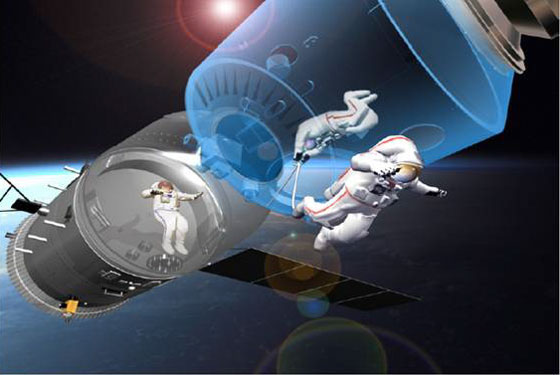Reports: China Chooses Fighter Pilot as First Spacewalker

China hasrevealed the identities of its first spacewalker and his two crewmates set tolaunch on the country?s third manned spaceflight next week, according to statemedia reports.
Chinese AirForce fighter pilot Zhai Zhigang, 42, will be the first Chinese spacewalkerduring the upcomingShenzhou 7 mission with crewmates Liu Boming and Jing Haipeng, The PeopleDaily Online reported Tuesday. The mission is slated to launch Sept. 25from Jiuquan Satellite Launch Center in China?s Gansu Province.
Accordingto the wire service AFP, Zhai is married and has one son. He will don a$15 million (100 million yuan) spacesuit for a planned40-minute spacewalk that is slated to include the deployment ofsmall satellite capable of broadcasting images to Earth via a CCD camera.
The Shenzhou7 crew is China?s largest to date. The country launched its first astronaut, YangLiwei, aboard the Shenzhou 5 spacecraft in 2003. A two-man mission, Shenzhou 6flown by astronauts Fei Junlong and Nie Haisheng, followed in October 2005.
Like Zhai,Liu and Jing are also 42 years old and fighter pilots with the People?sLiberation Army, AFP reported. They served as backups for China?sShenzhou 6 mission.
Accordingto China?s CCTV television network, Shenzhou 7 is slated to launch in lateevening on Sept. 25, with landing set for Sept. 28.
China isthe third nation after Russia and the U.S. to develop spacecraft and boosterscapable of launching humans into space. The country?s space program is a sourceof national pride and a symbol of China?s technical prowess.
Get the Space.com Newsletter
Breaking space news, the latest updates on rocket launches, skywatching events and more!
Shenzhouspacecraft are based on Russia?s Soyuz vehicles, but have been modernized andmodified by Chinese engineers. They consist of three segments — a crew capsule,orbital module and service module — and use solar panels to generate power.
The orbitalmodule has its own solar panels and can remain in orbit independently of thecrew and propulsion modules, unlike Russian Soyuz vehicles. But Shenzhouvehicles do return to Earth on land like Soyuz, with the spacecraft landing underparachutes and retrorockets on the plains of Inner Mongolia.
Chinesespace officials have said in the past that the country?s stepping stoneapproach to human spaceflight geared toward the development of a manned spacestation by 2010. Two follow-on missions, Shenzhou 8 and Shenzhou 9, areexpected to play a part in that goal, China Daily reported.
While Chinagears up for the launch of Shenzhou 7, the country is also looking to doubleits current cadre of 14 astronauts, also known as taikonauts. A new class ofastronauts has already begun training and is expected to add another 14spaceflyers to the Chinese corps, state media reported.
- China's First Spacewalk: A Prelude of Things to Come
- Shenzhou Rising: China's Second Manned Spaceflight
- Special Report: Emerging China, Engaging China
Join our Space Forums to keep talking space on the latest missions, night sky and more! And if you have a news tip, correction or comment, let us know at: community@space.com.

Tariq is the Editor-in-Chief of Space.com and joined the team in 2001, first as an intern and staff writer, and later as an editor. He covers human spaceflight, exploration and space science, as well as skywatching and entertainment. He became Space.com's Managing Editor in 2009 and Editor-in-Chief in 2019. Before joining Space.com, Tariq was a staff reporter for The Los Angeles Times covering education and city beats in La Habra, Fullerton and Huntington Beach. In October 2022, Tariq received the Harry Kolcum Award for excellence in space reporting from the National Space Club Florida Committee. He is also an Eagle Scout (yes, he has the Space Exploration merit badge) and went to Space Camp four times as a kid and a fifth time as an adult. He has journalism degrees from the University of Southern California and New York University. You can find Tariq at Space.com and as the co-host to the This Week In Space podcast with space historian Rod Pyle on the TWiT network. To see his latest project, you can follow Tariq on Twitter @tariqjmalik.









